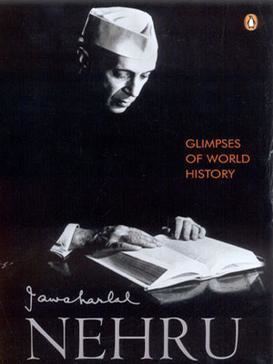9.2 /10 1 Votes9.2
5/5 MouthShut ISBN 978-0-19-562360-4 OCLC 21227307 | 4.2/5 Goodreads Pages 1192 Originally published 1934 Page count 1,192 Genre History | |||||||||||||||||||||||||||||||||
 | ||||||||||||||||||||||||||||||||||
Similar Jawaharlal Nehru books, History books, World history books | ||||||||||||||||||||||||||||||||||
Glimpses of World History, a book published by Jawaharlal Nehru in 1934, is a panoramic sweep of the history of humankind. It is a collection of 196 letters on world history written from various prisons in British India between 1930–1933. The letters were written to his young daughter Indira, and were meant to introduce her to world history.
The letters start off with one he sends to his daughter on her birthday. He says he is sad about not being able to send her any "material" gift from prison, so he would try to give her something he can "afford", a series of letters from his heart.
Written from prison, where he had no recourse to reference books or a library but his personal notes, Glimpses of World History contains the history of humankind from 6000 BC to the time of writing of the book. It covers the rise and fall of great empires and civilizations from Greece and Rome to China and West Asia; great figures such as Ashoka and Genghis Khan, Mohandas K. Gandhi and Vladimir Lenin; wars and revolutions, democracies and dictatorships.
He wrote about many cultures throughout the globe in detail because, as he himself said, he didn't like the way history was taught in schools where it was confined to the history of a single country and that too narrow, and he wanted his daughter Indira to know why people did what they did. It was possible only through knowing the history of the whole world.
The letters are written in informal language, with the contemporary and personal events too mentioned. They reflect the world view of Nehru, and his grasp of history. It could be considered as one of the first attempts at historiography from a non-Eurocentric angle - a statement that is itself subject to the charge of Eurocentrism, given the long history of historical writing outside of Europe, for instance in China (from The Classic of History, c. 550 BC) or the Islamic world (from Muhammad ibn Jarir al-Tabari in the 9th century AD to Biruni and Ibn Khaldun).
Nehru stated in his preface that The Outline of History by H. G. Wells was a major influence on the work. The New York Times described it as: "... one of the most remarkable books ever written.... Nehru makes even H.G. Wells seem singularly insular..... One is awed by the breadth of Nehru's culture."
In particular, his chapter on Genghis Khan and the Mongol invasion runs counter to dominant European views of the time. Prefacing his introduction to the Mongol empire, which was larger than the British empire and lasted as long, he said: "It would be foolish not to recognize the greatness of Europe. But it would be equally foolish to forget the greatness of Asia."
And he goes on to state: "Genghis is, without doubt, the greatest military genius and leader in history.... Alexander and Caesar seem petty before him." According to Jack Weatherford, this was possibly the first re-evaluation of the Mongol empire since the 18th century.
Nehru's interpretation of the Sepoy Mutiny—sparked by the order for the Sepoys to bite off the paper cartridges for their rifles which were greased with animal fat, namely beef and pork—is that "the Revolt of 1857-58 was the last flicker of feudal India."
